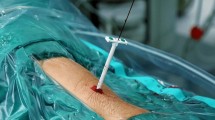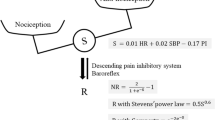Abstract
Postoperative pain remains a significant problem and the individual variance in postoperative pain is not fully understood. In recent years, there has been focus on identifying risk factors predicting patients with high postoperative pain intensity or consumption of analgesics, which may facilitate an improvement in rehabilitation. This study evaluates the relationship between preoperative experimental pain assessment and postoperative pain and opioid consumption. Forty-four patients with uni- or bilateral kidney stone disease scheduled for percutaneous nephrolithotomy were included. The preoperative pain thresholds were measured using electrical (single and 5 repeated) and pressure pain stimulation over the flank bilaterally (stone-side = operation side and control-side = non-operation side). Postoperative pain scores were recorded on a numerical rating scale and analgesic consumption was registered. The responses to repeated electrical stimuli (temporal summation) were preoperatively increased on the stone-side compared to the control-side (P = 0.016). Preoperative electrical pain thresholds from the control-side correlated inversely with postoperative opioid consumption (single stimuli: ρ = −0.43, P < 0.01; repeated stimuli: ρ = −0.45, P < 0.005). This correlation was more pronounced for the 22 patients with unilateral renal calculi (single stimuli: ρ = −0.54, P < 0.02; repeated stimuli: ρ = −0.58, P < 0.01). There were no other correlations between the preoperative sensory tests and postoperative pain or opioid consumption. This study showed a correlation between the preoperative electrical pain thresholds on the control-side and postoperative opioid consumption after percutaneous nephrolithotomy. Preoperative measurement of the electrical pain thresholds may, therefore, be useful as a screening tool to identify patients at high risk of postoperative pain.




Similar content being viewed by others
References
Kehlet H, Wilmore DW (2008) Evidence-based surgical care and the evolution of fast-track surgery. Ann Surg 248(2):189–198
Costantini R, Affaitati G (2011) Controlling pain in the post-operative setting. Int J Clin Pharmacol Ther 49(2):116–127
Kehlet H, Jensen TS, Woolf CJ (2006) Persistent postsurgical pain: risk factors and prevention. Lancet 367(9522):1618–1625
Kalkman C, Visser K, Moen J, Bonsel G, Grobbee D, Moons KG (2003) Preoperative prediction of severe postoperative pain. Pain 105(3):415–423
Hui YV, Abrishami A, Peng PWH, Wong JCF (2009) Predictors of postoperative pain and analgesic consumption a qualitative systematic review. Anesthesiology 111(3):657–677
Arendt-Nielsen L, Yarnitsky D (2009) Experimental and clinical applications of quantitative sensory testing applied to skin, muscles and viscera. J Pain 10(6):556–572
Brandsborg B, Dueholm M, Kehlet H, Jensen TS, Nikolajsen L (2011) Mechanosensitivity before and after hysterectomy: a prospective study on the prediction of acute and chronic postoperative pain. Br J Anaesth 107(6):940–947
Rago R, Forfori F, Materazzi G, Abramo A, Collareta M, Miccoli P et al (2012) Evaluation of a preoperative pain score in response to pressure as a marker of postoperative pain and drugs consumption in surgical thyroidectomy. Clin J Pain 28(5):382–386
Nielsen PR, Nørgaard L, Rasmussen LS, Kehlet H (2007) Prediction of post-operative pain by an electrical pain stimulus. Acta Anaesthesiol Scand 51(5):582–586
Bisgaard T, Klarskov B, Rosenberg J, Kehlet H (2001) Characteristics and prediction of early pain after laparoscopic cholecystectomy. Pain 90(3):261–269
Weissman-Fogel I, Granovsky Y, Crispel Y, Ben-Nun A, Best LA, Yarnitsky D et al (2009) Enhanced presurgical pain temporal summation response predicts post-thoracotomy pain intensity during the acute postoperative phase. J Pain 10(6):628–636
Hsu Y, Somma J, Yang C, Tsai P-S, Yang C-H, Chen C–C (2005) Predicting postoperative pain by preoperative pressure pain assessment. Anesthesiology 103(3):613–618
Pan PH, Coghill R, Houle TT, Seid MH, Lindel WM, Parker RL et al (2006) Multifactorial preoperative predictors for postcesarean section pain and analgesic requirement. Anesthesiology 104(3):417–425
Martinez V, Fletcher D, Bouhassira D, Sessler DI, Chauvin M (2007) The evolution of primary hyperalgesia in orthopedic surgery: quantitative sensory testing and clinical evaluation before and after total knee arthroplasty. Anesth Analg 105(3):815–821
Rudin a, Wölner-Hanssen P, Hellbom M, Werner MU (2008) Prediction of post-operative pain after a laparoscopic tubal ligation procedure. Acta Anaesthesiol Scand 52(7):938–945
Strulov L, Zimmer EZ, Granot M, Tamir A, Jakobi P, Lowenstein L (2007) Pain catastrophizing, response to experimental heat stimuli, and post-cesarean section pain. J Pain 8(3):273–279
Yarnitsky D, Crispel Y, Eisenberg E, Granovsky Y, Ben-Nun A, Sprecher E et al (2008) Prediction of chronic post-operative pain: pre-operative DNIC testing identifies patients at risk. Pain 138(1):22–28
Granot M, Lowenstein L, Yarnitsky D, Tamir A, Zimmer EZ (2003) Postcesarean section pain prediction by preoperative experimental pain assessment. Anesthesiology 98(6):1422–1426
Wilder-Smith CH, Hill L, Dyer R a, Torr G, Coetzee A (2003) Postoperative sensitization and pain after cesarean delivery and the effects of single IM Doses of tramadol and diclofenac alone and in combination. Anesth Analg 97(2):526–533
Werner MU, Duun P, Kehlet H (2004) Prediction of postoperative pain by preoperative nociceptive responses to heat stimulation. Anesthesiology 100(1):115–119
Buhagiar L, Cassar O a, Brincat MP, Buttigieg GG, Inglott AS, Adami MZ et al (2011) Predictors of post-caesarean section pain and analgesic consumption. J Anaesthesiol Clin Pharmacol 27(2):185–191
Aasvang EK, Gmaehle E, Hansen J, Gmaehle B, Forman J, Schwarz J et al (2010) Predictive risk factors for persistent postherniotomy pain. Anesthesiology 112(4):957–969
Aasvang EK, Hansen JB, Kehlet H (2008) Can preoperative electrical nociceptive stimulation predict acute pain after groin herniotomy? J Pain 9(10):940–944
Wilder-Smith OHG, Tassonyi E, Crul BJP, Arendt-Nielsen L (2003) Quantitative sensory testing and human surgery. Anesthesiology 98(5):1214–1222
Werner MU, Mjöbo HN, Nielsen PR, Rudin A (2010) Prediction of postoperative pain: a systematic review of predictive experimental pain studies. Anesthesiology 112(6):1494–1502
Cervero F, Laird JM (1999) Visceral pain. Lancet 353(9170):2145–2148
Giamberardino MA, de Bigottina P, Martegiani C, Vecchiet L (1994) Effects of extracorporeal shock wave lithotripsy on referred hyperalgesia from renal/ureteral calculosis. Pain 56:77–83
Stawowy M, Drewes AM, Arendt-Nielsen L, Funch-Jensen P (2006) Somatosensory changes in the referred pain area before and after cholecystectomy in patients with uncomplicated gallstone disease. Scand J Gastroenterol 41(7):833–837
Drewes AM, Gregersen HA-NL (2003) Experimental pain in gastroenterology. A reappraisal of human studies. Scand J Gastroenterol 38:1115–1130
Pedersen KV, Liao D, Osther SS, Drewes AM, Gregersen H, Osther PJS (2012) Distension of the renal pelvis in kidney stone patients: sensory and biomechanical responses. Urol Res 40(4):305–316
Silvasti M, Rosenberg P, Seppälä T, Svartling NPM (1998) Comparison of analgesic efficacy of oxycodone and morphine in postoperative intravenous patient-controlled analgesia. Acta Anaesthesiol Scand 42(5):576–580
Giamberardino M (1999) Recent and forgotten aspects of visceral pain. Eur J Pain 3(2):77–92
Frøkjaer JB, Andersen SD, Gale J, Arendt-Nielsen L, Gregersen H, Drewes AM (2005) An experimental study of viscero-visceral hyperalgesia using an ultrasound-based multimodal sensory testing approach. Pain 119(1–3):191–200
Brock C, Andresen T, Frøkjaer J, Gale J, Olesen A, Arendt-Nielsen L et al (2010) Central pain mechanisms following combined acid and capsaicin perfusion of the human oesophagus. Eur J Pain 14(3):273–281
Gracely RH (2006) Studies of pain in human subjects. In: McMahon SB, Koltzenburg M (eds) Wall and Melzack’s textbook of pain, 5th edn. Elsevier/Churchill Livingstone, Philadelphia, pp 267–268
Staahl C, Olesen AE, Andresen T, Arendt-Nielsen L, Drewes AM (2009) Assessing analgesic actions of opioids by experimental pain models in healthy volunteers—an updated review. Br J Clin Pharmacol 68(2):149–168
Soyupek S, Bozlu M, Armağan A, Ozorak A, Perk H (2007) Does experimental pain assessment before biopsy predict for pain during transrectal ultrasound-guided prostate biopsy? Urology 70(4):681–684
Granot M (2009) Can we predict persistent postoperative pain by testing preoperative experimental pain? Curr Opin Anaesthesiol 22(3):425–430
Olesen A, Andresen T, Staahl C, Drewes AM (2012) Human experimental pain models for assessing the therapeutic efficacy of analgesic drugs. Pharmacol Rev 64(3):722–779
Andresen T, Pfeiffer-Jensen M, Brock C, Drewes A, Arendt-Nielsen L (2012) A human experimental bone pain model. Basic Clin Pharmacol Toxicol
Eisenberg E, Midbari A, Haddad M, Pud D (2010) Predicting the analgesic effect to oxycodone by “static” and “dynamic” quantitative sensory testing in healthy subjects. Pain 151(1):104–109
Zwisler ST, Enggaard TP, Noehr-Jensen L, Mikkelsen S, Verstuyft C, Becquemont L et al (2010) The antinociceptive effect and adverse drug reactions of oxycodone in human experimental pain in relation to genetic variations in the OPRM1 and ABCB1 genes. Fundam Clin Pharmacol 24(4):517–524
Acknowledgments
This work was supported by a Grant from the Local Research Foundation of Fredericia and Kolding Hospitals. Mech-Sense, Aalborg University Hospital has received funding from The Danish Council for Strategic Research.
Conflict of interest
The authors declare that they have no conflict of interest.
Author information
Authors and Affiliations
Corresponding author
Rights and permissions
About this article
Cite this article
Pedersen, K.V., Olesen, A.E., Osther, P.J.S. et al. Prediction of postoperative pain after percutaneous nephrolithotomy: can preoperative experimental pain assessment identify patients at risk?. Urolithiasis 41, 169–177 (2013). https://doi.org/10.1007/s00240-013-0547-x
Received:
Accepted:
Published:
Issue Date:
DOI: https://doi.org/10.1007/s00240-013-0547-x




